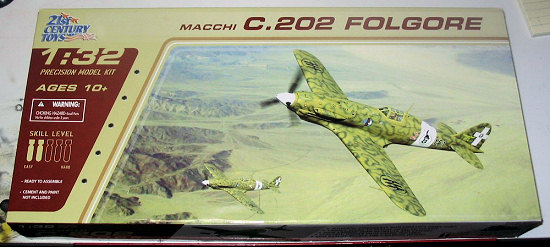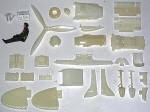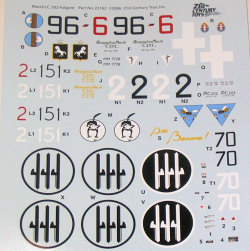
| KIT: | 21st Century Toys 1/32 Macchi C.202 Folgore |
| KIT #: | 22102 |
| PRICE: | $9.95 MSRP |
| DECALS: | Three options |
| REVIEWER: | Nathan Stevens |
| NOTES: |

| HISTORY |
The product of a collaboration between fascist allies, the Macchi MC.202 was the best fighter to serve in significant numbers in the Italian Regia Aeronautica. Designer Mario Castoldi started with the wings, landing gear and other features of the successful MC.200 and added the German-designed Daimler-Benz 601A-1 engine to a new fuselage. The result was the MC.202 Folgore (Thunderbolt), an able dogfighter that saw considerable action during the bloody battle for Italy.
Armed with two 12.7mm machine guns and later a 20mm cannon beneath each wing, the MC.202 was lightly armed compared to its Allied opponents, and its Alfa Romeo-built DB601 copy gave it a top speed of 370 miles per hour, far slower than the P-47 and P-51. But it had one ability none of them could match: the ability to turn. Col. Philip “Flip” Corcoran warned newcomers to the Mediterranean Theatre that no allied combat aircraft could out-turn the MC.202, and in the hands of a talented pilot the MC.202 was lethal.
The confused state of the Italian aviation industry meant that only around 1150 MC.202s were built, but its role in the war was far greater than its numbers would suggest. The first MC.202s were delivered in 1941 and the Folgore drew first blood on September 30, destroying three Hurricanes. The MC.202 flew 4000 missions against embattled Malta, claiming 100 victories over the RAF, and attacked Allied convoys in the Mediterranean. By the end of 1941, three Gruppi of MC.202s were active in Libya. Attrition was high and production was slow; at the type’s apex, on July 15, 1942, only 93 MC.202s were in North Africa.
The Regia Aeronautica also sent MC.202s to Tunisia in late 1942, committing 42 fighters to the battle. Despite desperate attempts to hold out, the allies overwhelmed the Italian forces, scoring the most vicious blow in a raid by B-25s that destroyed 15 MC.202s as they lines up to take off on March 31, 1943.
When the German advance in Russia bogged down, the Italians sent 14 MC.202s to the Eastern Front. The rapid collapse of the Italian armies meant that the MC.202s had time to fly just 17 sorties before being recalled to Italy, where the MC.202 took up defense of its homeland. Flying from Sicily and Sardinia, MC.202s opposed the landings at Sicily, and one even strafed the landing barge bringing General George S. Patton ashore. After 10 days, however, resistance in Sicily ended and the Allies looked to the mainland. While the Regia Aeronautica fought on, it was against a superior enemy air force. On September 8, 1943, Italy signed an armistice with the Allies.
This did not bring an end to the MC.202’s combat career. It flew on with the Italian Co-Belligerent Air Force against the Germans and with the Aviazione Nazionale Repubblicana against the Allies.
| THE KIT |
While it may be hard to imagine this kit winning any awards for anything save Junior categories, it does lend itself well to quick weekend builds, ceiling hangers, or that ‘next step’ for kids stepping out of the Snap-Tites. It seams a few steps back in technology, not far from the early Frog and Hawk kits twice my age, the primary difference being it’s scale. Parts count is low, detail is sparse, accuracy is a bit of an afterthought and fit doesn’t necessarily fit well. Now, on the other hand let’s not forget that $10 is $10. One really can’t expect more from a 1/32 kit of this price.
 First
off, there’s no sprue though you’ll still have to sand down the spots where the
gates once were. Parts come bagged, grouped by category as exampled in the
photo. The small bits are contained in a small parts tray which will come in
handy later for mixing paint! The pilot figure is prepainted which doesn’t hurt
my feelings. The arms are ‘poseable’ for whatever purpose but good luck getting
him to reach the stick. At the same time, I’ll probably be using the figure to
detract from the sparse cockpit detail.
First
off, there’s no sprue though you’ll still have to sand down the spots where the
gates once were. Parts come bagged, grouped by category as exampled in the
photo. The small bits are contained in a small parts tray which will come in
handy later for mixing paint! The pilot figure is prepainted which doesn’t hurt
my feelings. The arms are ‘poseable’ for whatever purpose but good luck getting
him to reach the stick. At the same time, I’ll probably be using the figure to
detract from the sparse cockpit detail.
The instructions are large enough to
be read from across the room, especially with the few parts involved. Detail
colors are referenced in basic terms such as black or interior tan. On the
other hand, the three well represented paint schemes come with info on each and
color call-outs for Model Master and Polly Scale. One of the kits fine points
is the decal sheet, which looks much more deserving of a large-name manufacturer
than some  of the large-name
manufacturer decals themselves. They’re in very-near perfect register. The
only exception being the black on silver ID tags which are a ways off but the
outlaying silver can be trimmed easily to make this one of the best looking
decal sheets I’ve yet seen.
of the large-name
manufacturer decals themselves. They’re in very-near perfect register. The
only exception being the black on silver ID tags which are a ways off but the
outlaying silver can be trimmed easily to make this one of the best looking
decal sheets I’ve yet seen.
The plastic is molded buff in color, strongly resembling resin parts. It’s also quite translucent though thickness varies from piece to piece. Panel lines are engraved albeit a bit too engraved and the edges are somewhat rounded into each groove which means painting is only going to highlight this feature all the more. There’s no fabric texture on control surfaces but the ribbing is present. The left wing is indeed slightly longer than the right as it should be. There are gauges molded into the instrument panel, for the most part in the proper layout. The cockpit consists of separate floor, sides, panel, seats and a few extras such as a trim wheel. Overall, not bad all things considered, the floor even has the heavy ribbing molded in and there’s a clear gunsight to top it all off.
There are several moving parts such as the canopy, propeller, and landing gear, including the inner doors. There’s a three piece gear bay to cover the center section in the fuselage but no detail further out, within the wings. One of these pieces is a wing spar though the support shouldn’t be needed as the lower wing is one piece from tip to tip.
Perhaps the biggest sore in the eye with this kit is the screw together fashion which holds the main parts together, four for the wings, four in the fuselage and one more to hold the wings to the fuselage. There are small plugs to cap these blemishes off and most of them are between panel lines but OOB or not, there’s going to be some filling and sanding on mine.
| CONCLUSIONS |
When it’s all said and done, this is a very basic kit and should be accepted as just that. At the same time, it leaves plenty to the imagination for aftermarket/scratchbuilding and for just under ten bills, it’s going to be hard to beat the bang for the buck.
Kit courtesy of my wife giving me my allowance early!
| REFERENCES |
Kit Instructions
If you would like your product reviewed fairly and quickly by a site that has nearly 350,000 visitors a month, please contact me or see other details in the Note to Contributors.